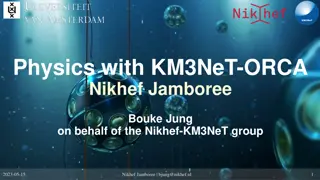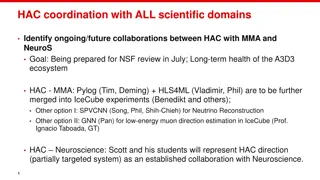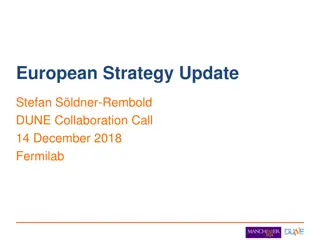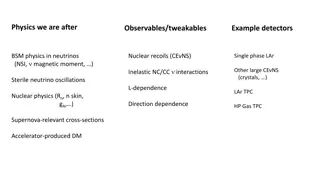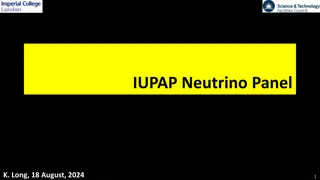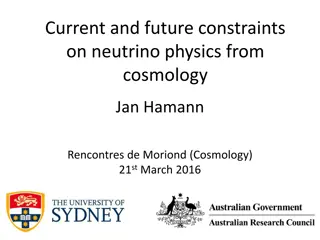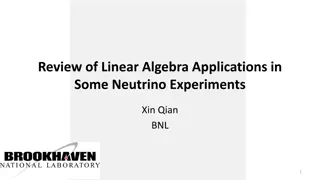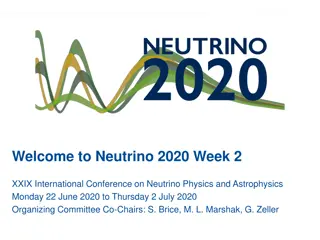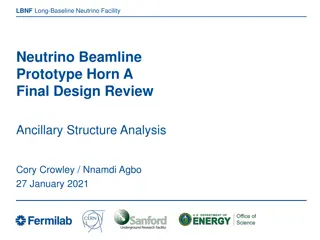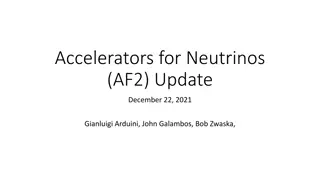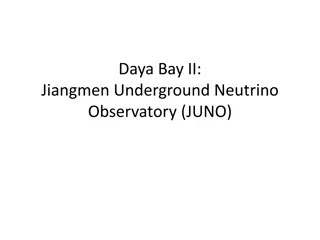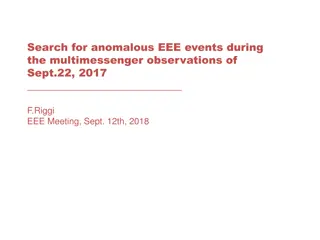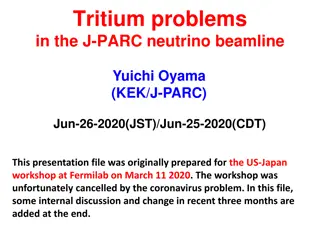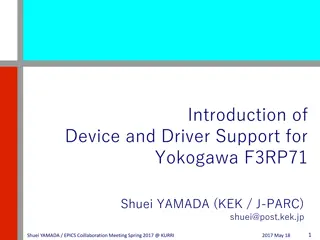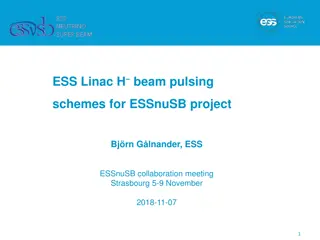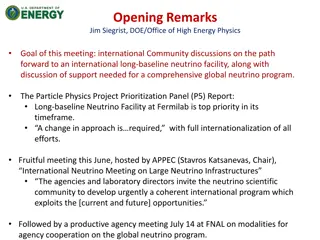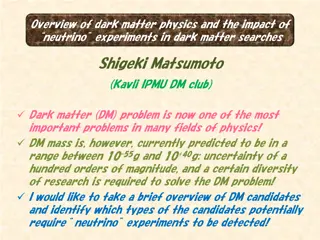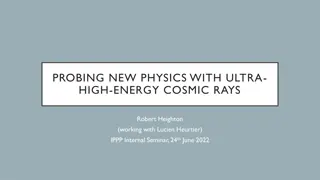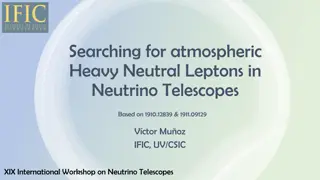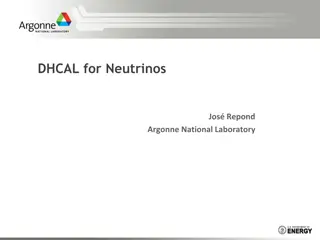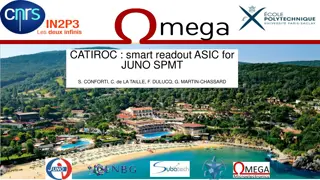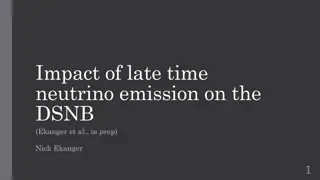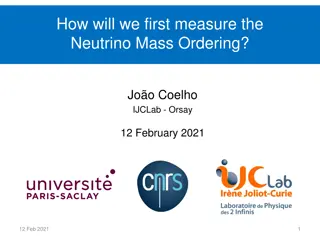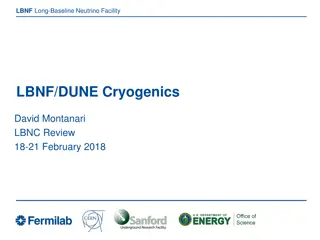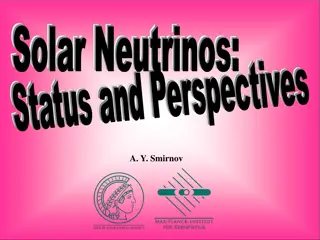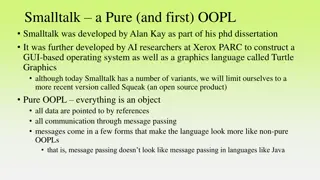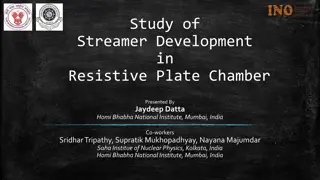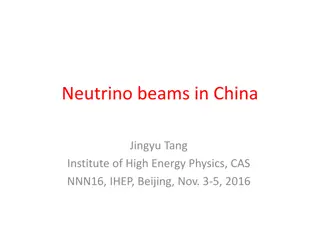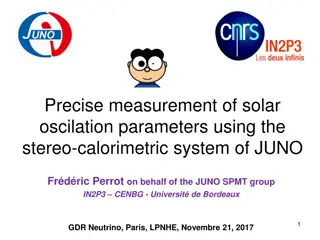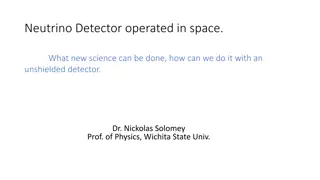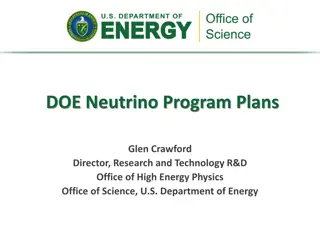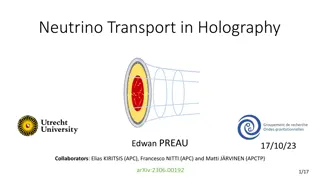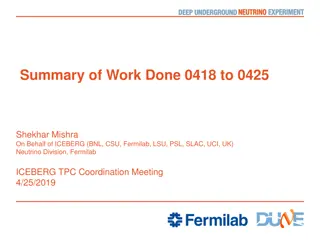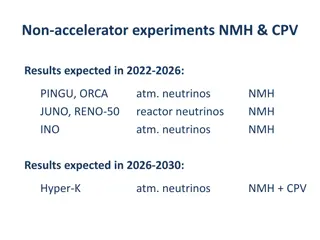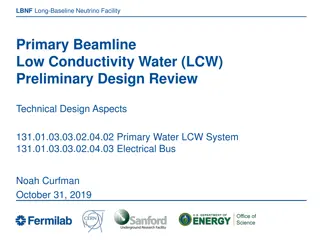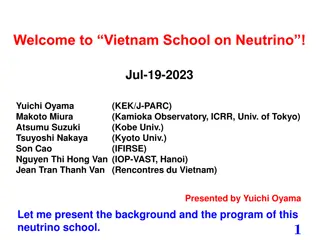Understanding Neutrinos: Insights from Nikhef Jamboree
Neutrinos, elusive particles, have 3 weakly interacting fields and oscillate between interaction and mass eigenstates. The Neutrino Mass Ordering (NMO) remains unknown with various hypothesis explored. The determination of NMO is crucial and methods utilizing matter effects and event rate asymmetry
3 views • 27 slides
Ongoing Collaborations in Scientific Domains for NSF Review Preparedness
Ongoing and future collaborations between the High-Performance Algorithm-System-Hardware Co-Design (HAC) team with Machine Learning and Analytics (MMA) and Neuroscience areas are outlined. Collaborations include merging Pylog and HLS4ML into IceCube experiments, utilizing SPVCNN and GNN for neutrino
2 views • 4 slides
European Strategy Update: Progress and Future Plans for DUNE Collaboration
The European Strategy Update in 2013 identified the long-baseline neutrino program as a key objective, leading to the formation of the DUNE collaboration. The upcoming update in 2020 aims to prioritize DUNE in the European neutrino program. The collaboration involves global partners aiming to addres
5 views • 12 slides
Exploring Neutrino Physics and Beyond with Observables and Detectors
Delve into the realm of neutrino physics, nuclear recoils, and other phenomena like sterile neutrino oscillations using detectors such as BSM and single-phase LAr inelastic NC/CC interactions. From NSI to Supernova-relevant cross-sections and accelerator-produced DM, this research journey covers a w
0 views • 5 slides
Evolution of the ICFA Neutrino Panel: A Journey Towards International Collaboration
The ICFA Neutrino Panel, established in 2013, has made significant contributions to the accelerator-based neutrino program. Through consultations with global neutrino communities and international meetings, the Panel has crafted a roadmap for future programs, emphasizing the complementarity of exper
1 views • 12 slides
Neutrino Detectors for NuStorm: Physics Goals and Detector Requirements
Physics goals for neutrino detectors in the NuStorm project include measuring exclusive neutrino cross sections, supporting long baseline programs, searching for sterile neutrinos, and improving measurements. Detector requirements involve reconstructing neutrino interactions, providing charge and pa
0 views • 21 slides
Neutrino Interactions with Liquid Argon at DUNE Near Detector Complex
The Deep Underground Neutrino Experiment (DUNE) aims to study neutrino oscillations using high-precision measurements with detectors like the Near Detector complex located downstream of the neutrino beam. Components such as ND-LAr and SAND play crucial roles in scanning energy spectra. SAND, a perma
0 views • 16 slides
Neutrino Platform Hall Access and Safety Guidelines
Guidelines for accessing and ensuring safety within the Neutrino Platform Hall at CERN, including registration, permissions, safety trainings, required equipment, online trainings, access points, and safety team responsibilities. Access is granted through registration at CERN, completion of safety t
1 views • 7 slides
Neutrino Mysteries Unveiled: Current Cosmological Constraints
Delve into the enigmatic world of neutrinos with a focus on their elusive properties like mass hierarchy, additional light neutrinos, and impact on cosmic background. Explore the unresolved questions surrounding neutrino physics from cosmological perspectives.
0 views • 29 slides
Linear Algebra Applications in Neutrino Experiments
Linear Algebra plays a crucial role in various neutrino experiments, enabling solutions in weighted least squares, energy estimation in EXO-200, and signal processing in LArTPC detectors. From Cartesian coordinates to minimizing uncertainties, linear algebra techniques contribute significantly to da
0 views • 38 slides
Neutrino 2020: International Conference Highlights
Explore the diverse experiences at Neutrino 2020, featuring plenary talks, poster sessions, virtual reality interactions, and engaging discussions via Slack. Learn about the block schedule, additional talks, and the online conference format with Q&A opportunities and poster competitions. Don't miss
0 views • 8 slides
Ancillary Structure Analysis for Long-Baseline Neutrino Facility Horn Prototype
The ancillary structure analysis for the Horn A prototype at the Long-Baseline Neutrino Facility involves detailed documentation tracking, FEA projects, and design considerations such as conductor stiffness and spider loading. The analysis approach includes rigorous documentation and peer review pro
0 views • 25 slides
Accelerators for Neutrinos Update: Latest Developments and Future Plans
Updates from the AF2 program on accelerator capabilities for neutrino physics, including community workshops, white papers, and plans for further development. Discussions on current needs, development areas, and collaborations with artificial neutrino sources. Focus on PIP-II exploitation and enhanc
0 views • 5 slides
Exploring the Daya Bay II: Jiangmen Underground Neutrino Observatory (JUNO)
Delve into the Daya Bay II project, encompassing the Jiangmen Underground Neutrino Observatory (JUNO), which secured a substantial funding commitment from the Chinese government. With construction slated to commence in 2015 and the first physics data expected by 2020, this ambitious venture has garn
0 views • 13 slides
Anomalous EEE Events During Multimessenger Observations
On Sept. 22, 2017, a high-energy neutrino event was observed by the IceCube Neutrino Observatory, potentially associated with a blazar. A search for anomalous EEE events during this period identified active telescopes and investigated coincident events. The significance of N-fold coincidences was di
0 views • 20 slides
Tritium Problems in J-PARC Neutrino Beamline - Recent Developments and Future Implications
This file discusses the issues related to tritium production in the J-PARC neutrino beamline, particularly focusing on the tritium release from steel walls to cooling water and air. It highlights the concerns regarding potential serious problems in the future and the measures undertaken to address t
0 views • 16 slides
Yokogawa F3RP71 Device and Driver Support by Shuei Yamada
Shuei Yamada from KEK/J-PARC presented on the development and support of Yokogawa F3RP71 (and F3RP61) devices, focusing on Linux CPU modules and runtime environments. The talk covered release plans, porting support from F3RP61, Yocto integration, API access, and future compatibility considerations.
0 views • 7 slides
ESSnuSB Project - Linac Upgrade for Neutrino Beam Generation
Explore the ESSnuSB project's linac upgrade featuring beam pulsing schemes and modifications, aiming to provide an additional 5 MW of beam power for neutrino generation. The upgrade options, pulse structure, beam parameters at 2.5 GeV, and different pulsing schemes are detailed with images and descr
0 views • 10 slides
International Efforts for Long-Baseline Neutrino Facility
International discussions are underway regarding the establishment of an international long-baseline neutrino facility and the need for comprehensive global support. The P5 report emphasizes the urgency of forming a new international collaboration to design and execute a Long-Baseline Neutrino Facil
0 views • 4 slides
Overview of Dark Matter Physics and Neutrino Experiments
The search for dark matter (DM) is a crucial challenge across various physics fields due to the wide range of predicted masses and uncertainties. DM candidates include stable, neutral, cold, and weakly interacting particles, with potential types like axions, SIMP-like, and WIMP-like DM. Neutrino exp
0 views • 9 slides
Unraveling the Mysteries of Ultra-High-Energy Cosmic Rays and Neutrinos
Delve into the exploration of ultra-high-energy cosmic rays and cosmogenic neutrinos in the quest to uncover new physics phenomena. Examining the GZK limit, cosmic accelerators, detection methods, and the potential for detecting tau neutrinos in Earth, this seminar presents a comprehensive overview
0 views • 28 slides
Exploring Heavy Neutral Leptons in Neutrino Telescopes
Atmospheric Heavy Neutral Leptons are being studied in neutrino telescopes to search for GeV Heavy Neutral Leptons, with a focus on their production in cosmic showers, flux at detectors, and signals from decay. Research explores minimal and non-minimal scenarios, revealing opportunities to probe a w
0 views • 9 slides
Challenges and Opportunities in DHCAL Technology for Neutrino Experiments
Funding cuts have impacted DHCAL activities for neutrino research, leading to limited progress. However, there is interest in utilizing existing technology for neutron yield measurements and muon energy evaluations. Efforts include addressing neutron interactions, optimizing materials, and revamping
0 views • 15 slides
Advancements in CATIROC Technology for Neutrino Observatories
CATIROC is a smart readout ASIC developed for experiments like JUNO, a neutrino observatory. With applications in photon counting, energy measurement, and data processing, CATIROC offers advanced features such as charge and time measurements, digital data conversion, and trigger outputs for improved
0 views • 20 slides
Late-Time Neutrino Emission Impact on DSNB Study
Explore the implications of late-time neutrino emission on the Diffuse Supernova Neutrino Background (DSNB) through core collapse supernovae simulations. The research delves into the dynamics of neutrino emission in different phases of supernova events and its relevance to understanding the DSNB.
0 views • 15 slides
Exploring Neutrino Mass Ordering and Its Implications
Delve into the world of neutrino mass ordering, from the methods of measurement to the significance of Normal versus Inverted Ordering. Discover how determining the mass hierarchy impacts our understanding of physical interactions, cosmology, decay processes, and more. Uncover the latest updates on
0 views • 25 slides
Review of Long-Baseline Neutrino Facility Cryogenics Performance and Recommendations
The review of cryogenics performance at the Long-Baseline Neutrino Facility highlighted the priority given to cryogenics testing on ProtoDUNE. The comprehensive commissioning plan includes testing of the cryostat, cryogenics, and detectors, with a focus on data collection and simulation validation.
0 views • 18 slides
Solar Neutrinos: Status and Perspectives in Neutrino Physics
This content delves into the evolving landscape of solar neutrinos, covering key milestones such as the establishment of flavor conversion by SNO in 2002, direct measurement of pp-neutrinos by BOREXINO in 2014, and the identification of the LMA MSW solution by KAMLAND in 2004. It explores the intric
0 views • 49 slides
Overview of Smalltalk Programming Language
Smalltalk, a pure object-oriented programming language, was initially developed by Alan Kay and further advanced at Xerox PARC. This versatile language features message passing, object-centric design, and a GUI-based system. Explore its classes, methods, class definitions, and more through the Brows
0 views • 17 slides
Study of Streamer Development in RPC for Neutrino Observatory Experiment
India-Based Neutrino Observatory (INO) aims to study neutrino properties using experiments like ICAL with RPCs. This work focuses on simulating streamer probability in RPCs using eco-friendly gas mixtures to replace R134a. Various simulation tools are employed to model streamer behavior and primary
0 views • 14 slides
Overview of Neutrino Beams in China: MOMENT Study Progress and Potential
The MOMENT study, initiated in 2013 in China, focuses on muon-decay medium baseline neutrino beam facility development. Using a Continuous Wave (CW) proton linac, the project aims to achieve 15 MW beam power for neutrino cross-section measurements and CP phase study. Recent progress includes the suc
0 views • 28 slides
Precise Measurement of Solar Oscillation Parameters Using Stereo-Calorimetric System of JUNO
The JUNO experiment aims to achieve a 3% energy resolution at 1 MeV by utilizing a stereo-calorimetric system with large and small PMT systems. The motivation for stereo calorimetry in JUNO is to improve energy resolution beyond current LS-based neutrino experiments and control non-stochastic term u
0 views • 31 slides
Exploring Neutrino Science in Space with Unshielded Detector - Opportunities and Innovations
The deployment of a neutrino detector in space presents a unique opportunity to conduct groundbreaking scientific research, leveraging the intense neutrino flux closer to the Sun. Key areas of focus include studying rare fusion neutrinos, observing neutrino oscillations during spacecraft transitions
0 views • 11 slides
Neutrino Program Plans and Recommendations by U.S. Department of Energy
The U.S. Department of Energy's Neutrino Program outlines significant changes and recommendations to pursue neutrino mass physics. These plans include international collaboration, short and long-baseline experiments at Fermilab, and the selection of small-scale experiments to address beyond the thre
0 views • 9 slides
Neutrino Transport in Holography Research Study
This research study delves into the realm of neutrino transport in holography, focusing on the interaction of neutrinos with dense QCD matter in the core. Motivations, formalisms, holographic set-up, and the holographic correspondence are explored using a toy model of quark matter in 4SYM and utiliz
0 views • 32 slides
Neutrino Division Work Summary: 0418-0425
Shekhar Mishra conducted various tests and coordination activities on behalf of ICEBERG Neutrino Division at Fermilab. FEMB tests with BNL firmware revealed responsiveness improvements in LN2 compared to air. Furthermore, FEMBs in CTS with DAQ displayed consistent channel behavior differences betwee
0 views • 4 slides
Overview of Non-Accelerator Neutrino Experiments and Programs
Non-accelerator experiments in the field of neutrino physics are expected to yield significant results between 2022 and 2030. Projects like PINGU, ORCA, JUNO, RENO-50, INO, Hyper-K, and DUNE aim to study neutrino mass hierarchy, CP violation, and non-oscillation phenomena. The design and constructio
0 views • 10 slides
Long-Baseline Neutrino Facility (LBNF) Primary Beamline LCW System Overview
The Long-Baseline Neutrino Facility (LBNF) Primary Beamline Low Conductivity Water (LCW) System comprises various technical design aspects including system operational scope, major system updates, design requirements, and component summary. It involves the provision of LCW cooling for magnets and po
0 views • 14 slides
Vietnam Neutrino School Overview
Vietnam School on Neutrino is an annual event started in 2017 to promote experimental neutrino physics in Vietnam. Led by Prof. Jean Tran Thanh Van, the school focuses on lectures, software and hardware training, group works, and excursions. With a mix of students from various countries, the aim is
0 views • 7 slides
Understanding Neutrino Mass, Mixing, and Flavor Symmetries
Neutrino physics involves studying mass, mixing, and flavor symmetries, which present new challenges when dealing with multiple neutrinos. The discussion includes neutrino states, mixing matrices, flavor content, vacuum mixing, standard parametrization, mixing angles, global fits, and the Tri-bimaxi
0 views • 59 slides
